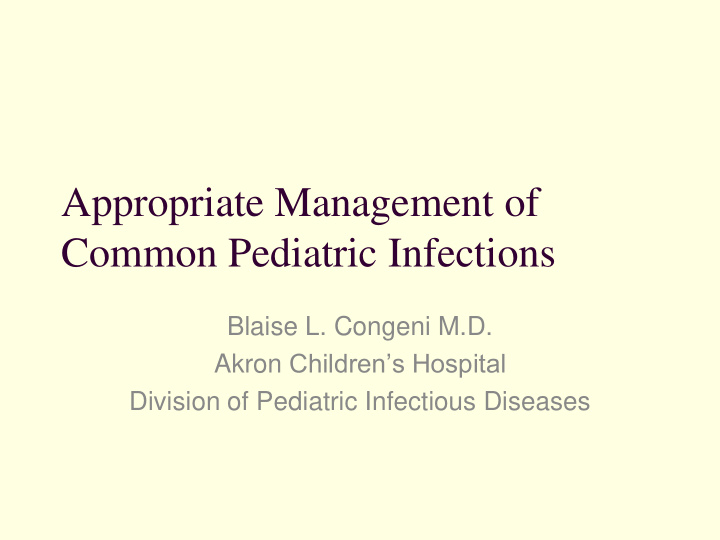



Appropriate Management of Common Pediatric Infections Blaise L. Congeni M.D. Akron Children’s Hospital Division of Pediatric Infectious Diseases
It’s all about the microorganism
The common pathogens Viruses Pneumococcus Haemophilus influenzae Moraxella catarrhalis Group A Strep S. aureus E. coli
Changes in bacterial flora Rapidly adjust to selective pressures Antimicrobials Vaccines Population dynamics Enhanced understanding of pathogenesis Virulence mechanisms
Sinusitis
The common pathogens Pneumococcus Haemophilus influenzae Moraxella catarrhalis S. aureus
Respiratory Pathogens from Sinus Aspirates Chow et al . Clin Infect Dis. (2012) 54 (8): e72-e112 . www.idsociety.org/Organ_System/#Lower/Upper%20Respiratory
Viral Upper Respiratory Infection Children develop on average 6 episodes/ year Infection type 90% of episodes due to virus 10% due bacteria
Chow et al . Clin Infect Dis. (2012) 54 (8): e72-e112 . www.idsociety.org/Organ_System/#Lower/Upper%20Respiratory
Duration of Simple URI in Children <1 yr of age Wald et al. Pediatrics. 1991, 87(2): 129
Clin Infect Dis. (2012) 54 (8): e72-e112 . www.idsociety.org/Organ_System/#Lower/Upper%20Respiratory
IDSA ABRS Guideline limits Use of antimicrobials limited by few studies with varying diagnostic criteria Clinical diagnosis remains problematic Radiographic imaging of limited value Nasal swabs not helpful
IDSA Guideline for ABRS diagnosis Onset with persistent s/sx ≥ 10 days Onset with severe symptoms or signs of high fever (≥ 39 ⁰ C) AND purulent nasal discharge OR facial pain lasting 3-4 consecutive days Onset with worsening symptoms or signs new onset fever, headache OR worsening nasal discharge (after initial improvement of typical viral URI) Chow et al . Clin Infect Dis. (2012) 54 (8): e72-e112 . www.idsociety.org/Organ_System/#Lower/Upper%20Respiratory
Chow et al . Clin Infect Dis. (2012) 54 (8): e72-e112 . www.idsociety.org/Organ_System/#Lower/Upper%20Respiratory
IDSA Guideline for ABRS approach Recommended that empiric antimicrobial treatment be promptly initiated when ABRS is indicated Delaying or withholding antimicrobial therapy for ABS is not recommended. “Watchful waiting” is not thought to have a role when more rigorous diagnostic criteria are applied.
IDSA Guideline for ABRS empiric antimicrobial choice Amoxicillin/clavulanate is recommended over amoxicillin alone High dose amoxicillin/clavulanate is recommended for areas with high rates of invasive PNS pneumococcus severe infection attendance at daycare age < 2 years, antibiotic use in the past month immunocompromised. Chow et al . Clin Infect Dis. (2012) 54 (8): e72-e112 . www.idsociety.org/Organ_System/#Lower/Upper%20Respiratory
Chow et al . Clin Infect Dis. (2012) 54 (8): e72-e112 . www.idsociety.org/Organ_System/#Lower/Upper%20Respiratory
IDSA Guideline for ABRS role for other antimicrobials 2 nd and 3 rd generation cephalosporins no longer recommended for empiric therapy of ABRS Macrolides are not recommended TMP/SMX is not recommended Doxycycline may be used in children >7 yrs of age Chow et al . Clin Infect Dis. (2012) 54 (8): e72-e112 . www.idsociety.org/Organ_System/#Lower/Upper%20Respiratory
IDSA Guideline for ABRS β lactam allergy Clindamycin with cephalosporin for PCN allergic pts (non-type 1 ) Clinda use limited in areas of high resistance Pts with type 1 hypersensitivity Levofloxacin recommended Doxycycline for children > 7 yrs of age Chow et al . Clin Infect Dis. (2012) 54 (8): e72-e112 . www.idsociety.org/Organ_System/#Lower/Upper%20Respiratory
Community Acquired Pneumonia
The common pathogens Pneumococcus Mycoplasma pneumoniae S. aureus
Clinical Infectious Diseases Advance Access published August 30, 2011
PIDS/IDSA CAP Guideline Outpatient management Clinical Evaluate tachypnea, hypoxemia, toxicity Laboratory Blood culture not indicated in mild CAP Consider viral testing (e.g. influenza) Sputum culture in moderate CAP Chest x-ray Consider with moderate CAP pts not improving or worsening
PIDS/IDSA CAP Guideline Outpatient management • Children <5 years with likely viral CAP Observation • Suspect mild to moderate bacterial CAP High dose amoxicillin No benefit of cephalosporins over high-dose amoxicllin azithromycin not reliable in areas of high PRP Suspect atypical pneumonia azithromycin
PIDS/IDSA CAP Guideline Inpatient management Ceftriaxone is preferred over ampicillin in areas of increased high level PRP Consider combination with azithromycin for school age and above Consider vancomycin Worsening clinical course Imaging studies suggestive of CA-MRSA
Pharyngitis
The common pathogens pharyngitis Group A streptococci Group C, G streptococci Neisseria gonorrheae Archanobacterium haemolyticum Fusobacterium necrophorum Mycoplasma pneumoniae EBV, HSV
McIsaac et al. Empirical Validation of Guidelines for the Management of Pharyngitis in Children and Adults. JAMA, 2004, 291(131):1587
Management of Pharyngitis Pen VK, benzathine PCN, and amoxicillin remain the drugs of choice For penicillin allergic patients: Cephalosporin (cephalexin) for non type 1 Macrolide, clindamycin for type 1 Empiric treatment recommendations vary with Centor score of 3 or 4 ACH, AAFP, CDC: can treat empirically IDSA, AHA: should not treat empirically
Urinary Tract Infections
Urinary Tract Infections Common antimicrobial resistance concerns Amoxicillin - >50% resistance TMP/SMX – 20-30% resistance Emerging antimicrobial concerns Amp C β -lactamase ( Enterobacter, Serratia, Citrobater ) Extended spectrum β -lactamase ( Klebsiella, E. coli )
Extended Spectrum β lactamase producers (ESBLs) Found most often in Klebsiella and E. coli Confers resistance to most β lactams (except for carbapenems) In the U.K. rates of resistance to 3 rd generation cephalosporins has increased from 2% (2000) to 14% (2011) Spain, Italy, Turkey – rates 25-50% Asia, South America - higher
Urinary Tract Infection AAP Guidelines Apply to children ≤ 24 months of age Catheterized specimen recommended 5x10 4 cfu considered positive No indication for prophylaxis No indication for VCUG with 1 st UTI In absence of sepsis Abnormal renal US
Skin Infections
Antimicrobial management of skin infections Consider pathogens S. aureus , MRSA S. pyogenes Other β hemolytic streps Pseudomonas Pasteurella, Aeromonas Consider host Immunosuppression Consider location
Skin Infection antimicrobials S. aureus clindamycin TMP/SMX doxycycline (> 7yrs of age) β lactams Empiric skin infection clindamycin TMP/SMX plus β lactam mupirocin 2% topical ointment
MRSA Skin Infection Epidemic of MRSA skin infection continues Incision and drainage has a clear role in management The role of antimicrobial therapy is less clear after I&D Studies comparing placebo to antibiotic suggest non-inferiority
Skin Infection antimicrobials Recent study suggests inferiority of TMP/SMX to clindamycin for purulent skin infections likely due to S. aureus Data suggests that use of an antimicrobial after I&D may provide benefit in preventing relapse or reoccurrence.
Antimicrobials New and changing Vancomycin Linezolid Cefepime Ceftaroline Daptomycin Telavancin
Recommend
More recommend